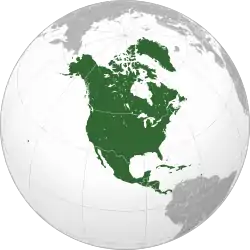Old World
The Old World consists of Africa, Europe, and Asia, or Afro-Eurasia, most of which encompasses the Eastern Hemisphere, regarded collectively as the part of the world known to the inhabitants thereof before contact with the Americas.[1] The Western Hemisphere, particularly the Americas, are therefore contrariwise called the New World.[2] South Africa and Southern Africa can be regarded as New World, such as that of New World wine.


Etymology
In the context of archaeology and world history, the term "Old World" includes those parts of the world which were in (indirect) cultural contact from the Bronze Age onwards, resulting in the parallel development of the early civilizations, mostly in the temperate zone between roughly the 45th and 25th parallels north, in the area of the Mediterranean, including North Africa. It also included Mesopotamia, the Persian plateau, the Indian subcontinent, China, and parts of Sub-Saharan Africa.
These regions were connected via the Silk Road trade route, and they have a pronounced Iron Age period following the Bronze Age. In cultural terms, the Iron Age was accompanied by the so-called Axial Age, referring to cultural, philosophical and religious developments eventually leading to the emergence of the historical Western (Hellenism, "classical"), Near Eastern (Zoroastrian and Abrahamic) and Far Eastern (Hinduism, Buddhism, Jainism, Sikhism, Confucianism, Taoism) cultural spheres.
Applicability
The term has been discussed as problematic, since it applies a colonial perspective of discovery and does not do justice to neither the historic or geographic complexity of world regions. Instead it is argued that both worlds of the world and age of Western colonialism rather entered a temporal new world,[3] as in the modern world.
Other names
The mainland of Afro-Eurasia (excluding islands or island groups such as the British Isles, Japan, Sri Lanka, Madagascar and the Malay Archipelago) has been referred to as the "World Island". The term may have been coined by Sir Halford John Mackinder in The Geographical Pivot of History.[4]
The equivalent of the Old World had names in some of its ancient cultures, including Midgard in Germanic cosmology and Oikoumene among the Greeks.
See also
References
- "Old World". Merriam-Webster Dictionary.
- "New world". Merriam-Webster Dictionary.
- "The Old World-New World Debate and the Columbian Exchange". Wondrium Daily. 31 January 2021. Retrieved 10 April 2022.
- See Francis P. Sempa, "Mackinder's World." American Diplomacy (UNC.edu). Retrieved 8 September 2018.
Continents of Earth | ||||||||
|---|---|---|---|---|---|---|---|---|
| ||||||||
| ||||||||
| ||||||||
Western world and culture | |
|---|---|
| Foundations | |
| History | |
| Culture | |
| Philosophy | |
| Religion | |
| Law | |
| Contemporary integration |
|
.svg.png.webp)
.svg.png.webp)
.svg.png.webp)
.svg.png.webp)


.svg.png.webp)
_political.svg.png.webp)
.svg.png.webp)
.svg.png.webp)
.svg.png.webp)